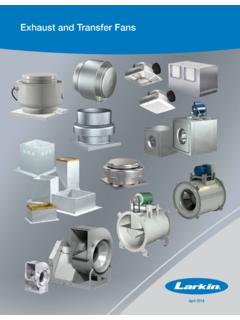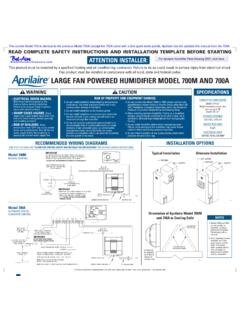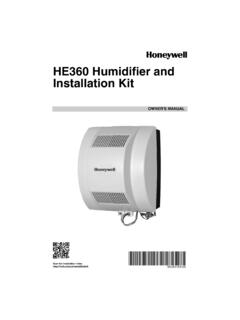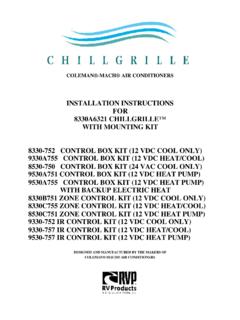Transcription of Commercial Kitchen Hood Installation and Maintenance …
1 Commercial Kitchen hood Installation and Maintenance Manual Receiving Shipments Upon receiving unit, check for any interior or exterior damage, if found, report it to the carrier immediately. Check that all accessory items are accounted for and damage free. Caution! We strongly suggest hood Installation should only be performed by a qualified and licensed mechanical contractor who is familiar with the level of involvement for proper Installation . Insure proper safety precautions are taken, permits are obtained, and code requirements are met. Save these instructions. This document is the property of the owner of this equipment and is required for future Maintenance . Leave this document with owner after Installation or service has been completed. 2012 Table of Contents hood Basic Hanging End-to-End Back-to-Back 4 Grease Trough and Cup Back Return Front Supply Splash Ceiling End Duct Trouble hood Installation Instructions 1 When uncrating, handling, or installing, the installer should exercise extreme caution to protect the stainless steel surfaces from damage, as they are costly to repair.
2 The installing contractor for the Kitchen Ventilation System is responsible for verifying field measurements of the constructed Kitchen area. Consult project plans when determining exact location of the hood (s). Determine how the hood will be hung and prepare the structural support system using inserts, shields, angle iron, etc., and threaded rod with turn buckles (hanging material by others). Verify that the materials used are sufficient to support the weight of hood and hanging system. (Refer to NFPA-96 for proper Installation methods and materials.) All Larkin Industries, Inc. hoods are provided with hanging brackets on top of hood , threaded rod should be used with necessary nuts, washers, etc (see fig. 1). Turnbuckles are recommended for leveling (see fig. 2). Recommended mounting height from bottom edge of hood to the finished floor is 6 -6 , (18 -24 from bottom edge of filter to cooking surface for Back Shelf type models).
3 Hoods should be hung level, and where possible, the exhaust outlet should be in line with the exhaust fan opening. Duct runs, offsets, elbows, etc. should be simple and direct as possible (see fig. 3). When preliminary preparations have been made, prepare the hood for lifting by providing necessary manpower, forklift, crane, duct jacks, etc. Be sure to provide adequate safeguards to prevent damage to the hood , property, and insure safety of personal (see pg 3&4 for multiple section hoods). If a Back Return (BR) plenum is provided with the hood , this should be hung first at the standard hanging height (see pg 6). When all hanging material has been attached, lift the hood in to position and secure to structural framing, leveling the hood by using the turnbuckles. Insure proper tension is placed on each hanging rod for even weight distribution. If the hood has a Front Perforated Supply plenum (FPSP), this should be installed now (see pg 7).
4 The grease trough needs to be attached to the bottom of filter rail, sloped toward the removable grease container for proper drainage. Attach grease container to the studs at the end of grease trough. Install light bulbs in light fixtures (bulbs by others). Use any well-recognized brand with a maximum of 100 watts. Install exhaust ductwork. Exhaust duct systems must be continuously welded liquid tight per NFPA-96 requirements. Install supply ductwork (by others) per SMACNA guidelines. Complete all electrical wiring based on Installation wiring diagram provided (by certified electrician). If hood is manufactured with factory pre-piped fire suppression system, a certified fire system distributor is responsible for final field hookup, testing, and certification of the system. If the hood is not provided with a fire suppression system, a certified fire suppression distributor must be contracted to install, test and certify a fire suppression system (by others).
5 Protect hood at all times by wrapping it in plastic or other suitable material, until all other work is accomplished and system is ready to be put into operation. Make sure to use stainless steel polish to clean hood . To prevent scratching do not use abrasives on hood . Warning! Do not penetrate the integrity of the hood grease containment area when hanging hood . Penetrating the grease containment area will void warranty and listing on the hood . 2 Commercial Kitchen hood Basic Hanging Methods Figure 1 Simple hanging method that requires all thread, two washers, and three heavy nuts. Figure 2 Example of using turn buckle designed for easy adjustment of hood level. Figure 3 An overview of using turn buckles for hood Installation .
6 Methods of hood Installations may vary depending on local code requirements. Note: Hanging material provided by others. 3 Commercial Kitchen hood End-to-End Configuration Align hoods and bolt together. Apply silicone to seam between hood sections. insert T strip and temporarily attach with tape.
7 After silicone has dried, remove tape. Slide hem strip over raw ends of hood sections Note: Hanging material provided by others. and pop rivet in place. 4 Commercial Kitchen hood Back-to-Back Configuration Align hoods and bolt together. Apply silicone to seam between hood sections. Note: Hanging material provided by others. insert T strip and temporarily attach with tape. after silicone has dried, remove tape. 5 Commercial Kitchen hood Grease Trough and Cup Installation NOTICE No two kitchens are the same and require different schedules of Maintenance . Check grease cup daily for the first few weeks of normal operation to determine a proper cleaning schedule.
8 The grease cup will need to be emp- tied more frequently with heavier cooking loads. Hang grease cup on the key studs provided below the filter rack. Slide grease trough over the two key studs at an angle with the smaller portion of the keyhole at the top position. Slide trough down to lock into place. Once the trough has been installed, check to make sure it is tilted towards the grease cup shown in the figure below. VERY IMPORTANT Make sure that the small portion of the keyhole is in the up position for proper Installation . 6 Commercial Kitchen hood hood Options Back Return plenum Hang Back Return plenum at standard hanging height. (8 -6 top) with threaded rod attach to wall at bottom.
9 Hang hood against Back Return plenum . Note: Hanging material provided by others. 7 Commercial Kitchen hood hood Options Front Perforated Supply plenum (FPSP) Hang FPSP using all thread rod against the upper front of the hood . Attach plenum to channel located on the front edge of the hood . Collars maybe shipped mounted or loose. If the collars are loose, install diffuser plate, attach collar to the plenum , and seal. Double Discharge (FPSP-AC) Standard FPSP (12 -16 ) Note: Hanging material provided by others. Seal collars using approved methods. 8 Commercial Kitchen hood hood Options Stainless Steel Wall Splash Panels Each overlap reduces the overall length by 3/8 . Add the number of overlaps and multiply by 3/8 . Divide this measurement by two.
10 Start the first panel (no overlap) at this distance from the end of hood . Install remain- ing panels using overlap to trim previous panel. Use side trim to extend panels flush with ends of the hood . Inside and/or outside corner trim my also be used. Overlap omitted on one piece wall panels. 9 Commercial Kitchen hood hood Options Ceiling Enclosure Note: Fastening material provided by others End Curtains Duct Work 10 Ductwork Installation Upon customer request, Larkin Industries, Inc. may furnish ductwork. All ductwork should be installed in accordance with local codes. The installing contractor is responsible for adher- ence to codes and restrictions. Generally, the duct system will perform best and will insure easy Installation if installed in the most direct and simple manner. NFPA-96 requires that the exhaust duct must be installed using 16-gauge carbon steel or 18-gauge stainless steel with all joints and seams welded liquid tight.











